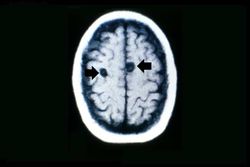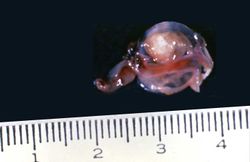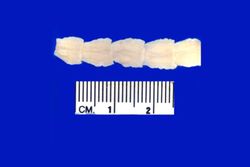Difference between revisions of "IPLab:Lab 11:Cysticercosis"
Seung Park (talk | contribs) |
Seung Park (talk | contribs) (→Reference) |
||
| Line 19: | Line 19: | ||
== Additional Resources == | == Additional Resources == | ||
=== Reference === | === Reference === | ||
| − | + | * [http://emedicine.medscape.com/article/215589-overview eMedicine Medical Library: Cysticercosis] | |
| + | * [http://emedicine.medscape.com/article/781845-overview eMedicine Medical Library: Cysticercosis in Emergency Medicine] | ||
| + | * [http://www.merckmanuals.com/professional/infectious_diseases/cestodes_tapeworms/taeniasis_solium_and_cysticercosis.html Merck Manual: Taeniasis Solium and Cysticercosis] | ||
=== Journal Articles === | === Journal Articles === | ||
Revision as of 04:39, 25 August 2013
Contents
Clinical Summary[edit]
This 29-year-old woman was admitted to the hospital because of repeated tonic-clonic seizures. The patient was a tour guide leading groups of tourist to Tibet for two-month walking/camping tours in the Himalayas. Her seizures were easily controlled by intravenous administration of phenytoin. The WBC count was 13,000, with 5% eosinophils; the erythrocyte sedimentation rate was 19. A cranial CT performed with and without contrast revealed two ring-enhancing lesions. The patient underwent a craniotomy and excisional biopsy.
Surgical Specimen[edit]
Histopathologic exam revealed a capsule of dense connective tissue surrounding a cavity that contained a partially degenerated scolex of Taenia solium.
Images[edit]
Study Questions[edit]
Additional Resources[edit]
Reference[edit]
- eMedicine Medical Library: Cysticercosis
- eMedicine Medical Library: Cysticercosis in Emergency Medicine
- Merck Manual: Taeniasis Solium and Cysticercosis
Journal Articles[edit]
Images[edit]
Related IPLab Cases[edit]
| |||||
A tonic-clonic seizure involves loss of consciousness followed by tonic, then clonic, convulsions.
A normal white blood cell count is 4000-11,000 cells/mm³.
An elevated erythrocyte sedimentation rate is a non-specific indicator of inflammation.



